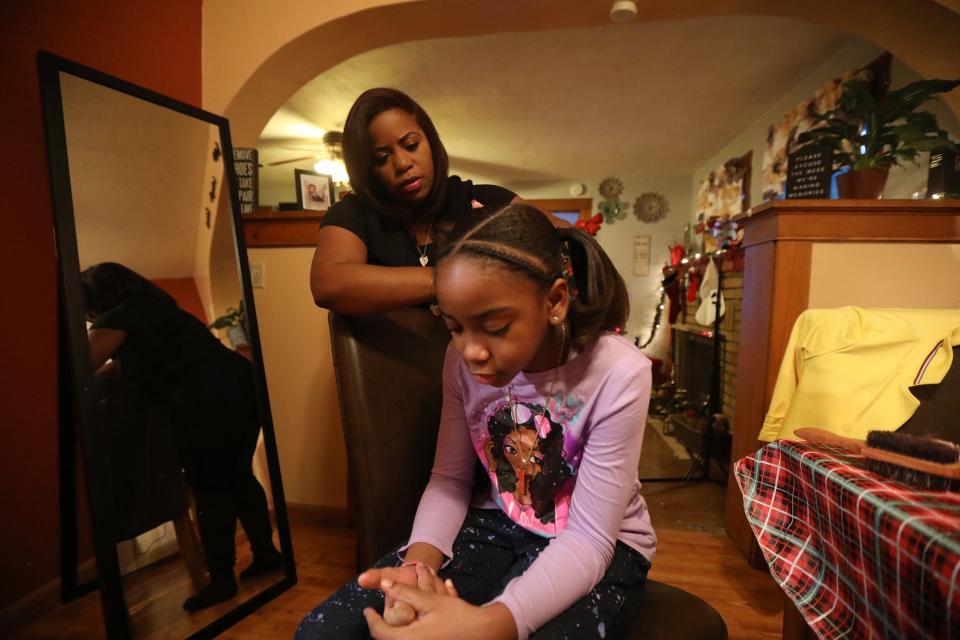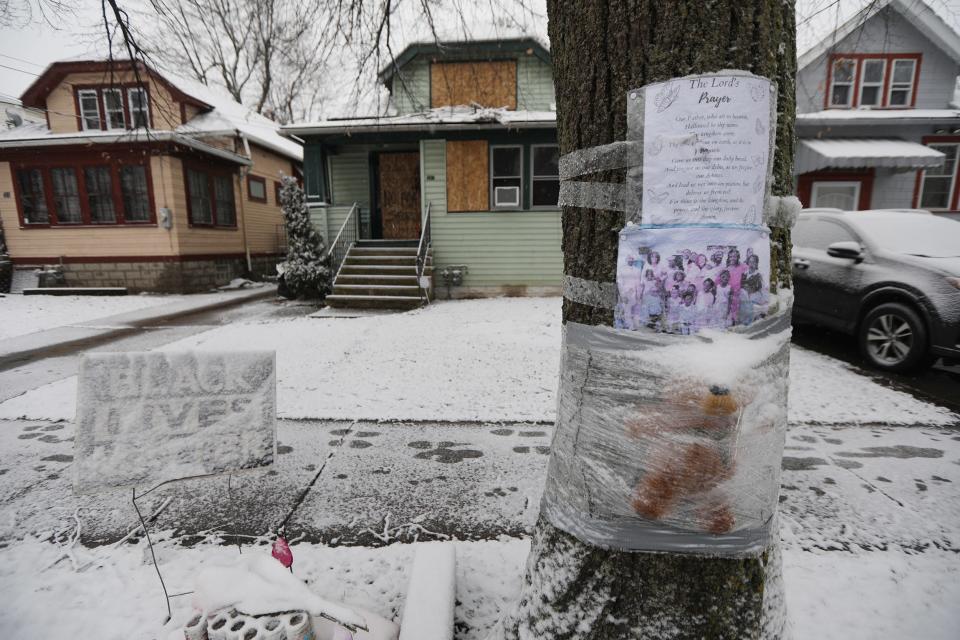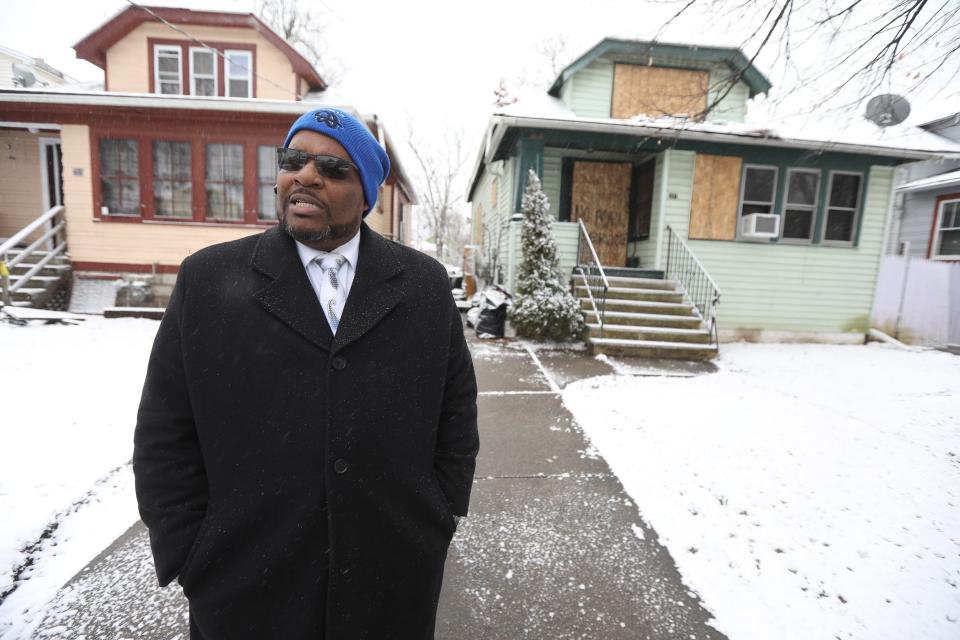'The pain is real.' Buffalonians push on through fire, ice and grief
- Oops!Something went wrong.Please try again later.
The worst part wasn't that Damar Hamlin fell.
It was watching the Buffalo Bills safety stand, then fall again.
That’s when Buffalo schoolteacher Davette Wright knew something was very wrong. And it's when she started to pray.
On the Monday after a rough year, even on a school night, Wright did what she always did when her beloved Bills played. She went to her grandmother’s house. The Bills are what her family looks forward to sharing each week: her mother and aunts and uncles and cousins.
That night was meant to be a moment for joy, after a year of unspeakable tragedy in Buffalo.
A racially motivated massacre at Tops supermarket in May had left 10 dead and countless more learning to heal. A generational blizzard in December killed dozens, left to freeze while stranded in cars or in homes without power. A housefire on New Year’s Eve, just behind Wright’s own home, found a mother grieving for five little children.

For Wright and for many others in Buffalo, the tragedies of the past year aren’t stories or statistics. Especially for those on the city's predominantly Black East Side, they have hit close to home. They reverberate through friends and family in a tangled web of heartbreak and near-misses and what-ifs.
“I can’t even begin to tell you how difficult this year has been,” Wright said. “It was a hit after a hit. ... We need a break.”
But it didn’t come. In the first quarter of that game against Cincinnati on Jan. 2, she watched Damar Hamlin go inexplicably limp, collapsing to the field after jumping up from a routine tackle.
His heart had stopped, Wright and her family would soon learn — stunned at just the wrong instant and in just the wrong place, a catastrophic injury so unlikely it makes a lightning strike seem commonplace.
“When that happened, it was just tears,” Wright said, “It was like, ‘Wow, another thing.’ Another devastating thing."
Hamlin has since recovered enough to leave the hospital, only to watch from the sidelines as his team lost at home to the same Bengals team he'd played three weeks before. It was one more heartbreak for a famously hard-luck city whose fans have come to believe its stadium suffers from an ancient curse.
More:The Buffalo Bills' ghostly gridiron
For Wright, the woes on the field feel inextricable from Buffalo's other grim tragedies. The Bills have been a source of hope, something she hoped Buffalo could finally brag about in a year that has left city officials taxing the language of resilience.
"The only thing that has kept me going this year is prayer," Wright said. "The power of prayer, and just people being around you."
Hamlin wasn't just another player when she saw him fall on Jan. 2. Her cousin, a police officer, had met Hamlin after the massacre at Tops supermarket.
“Damar came and donated his time when the mass shooting happened,” she said, arriving with his teammates to hand out food to a community that found itself without a supermarket. “It was close to us when (his injury) happened. It touched us all.”
The shooting, too, was terribly close. In the minutes before the mass murderer opened fire on May 14, 2022, Wright had just dropped off her then-9-year-old daughter, Dakota, at a dance studio a block north on Jefferson Avenue. Most weeks she would have hung around the Masten Park neighborhood, maybe picked up snacks for her daughter at the store.
That day, she uncharacteristically drove back home all the way across town. She’s thankful to be alive, but it haunts her. As police sirens blared at the supermarket, her daughter’s dance class went into lockdown. Wright rushed to meet her, only to be blocked by emergency vehicles.
After she learned what happened, Wright’s daughter couldn’t bear to return to dance classes. She hasn't danced since.
But 2022 had more in store. A death in the family. A stabbing at the school where Wright teaches.
During the historic Dec. 23 blizzard in Buffalo, with the city blanketed in 4 feet of snow, she and her family huddled together on a street left unplowed for five days. She saw firefighters in snowshoes delivering groceries from home to home, running to put out a small fire across the street. She felt hope.

Then, the unspeakable arrived again. A morning blaze at 207 Dartmouth St., a home that sits behind Wright’s. Six children were inside. Wright remembered meeting their grandfather, Clarence Liggans, one morning at the bus stop, where she sometimes walks her own daughter in the morning.
She waited for news, hoping against hope that the children would be okay — children who attended the school where she teaches second grade.
“They’ll make it,” she remembers telling another teacher on the phone. “They’ll make it.”
A pastor struggles to help a family who lost five children

Pastor Duane Price was preparing for his Saturday sermon on New Year’s Eve morning when he saw the call from Clarence Liggans.
Clarence and his wife, Lisa, were fairly new congregants at his church, Cornerstone Church Ministries. But already it was a normal event for Clarence to call him up with a joke, or just to say he planned to be at the service. This call was different.
“He was crying, and telling me about the house being on fire,” Price remembered.
Price rushed to action, postponing church services and driving to the scene at Liggans’ home on Dartmouth Street. He followed Liggans to the hospital to be with three generations of his family as they recovered — or as they grieved.
Though Lisa Liggans was able to carry out the youngest child before being hospitalized herself, five children would eventually succumb to the fire, from 2-year-old Nehemiah — a little boy who loved cars and trucks so much they were the one thing he wouldn’t share, his mother told news station WKBW — to 10-year-old Aniyah, an avid Girl Scout who’d hoped one day to become a doctor.
Price helped arrange fundraiser after fundraiser for the family, saying that the generosity of the city has been a blessing in a year that has already seen so much grief, and so many deaths.
He’s never seen a year like the one Buffalo has endured. “Not in my 57 years,” he said, “to get hit like we’ve been hit.”
Price, too, had been touched by multiple tragedies last year before the fire that now consumes his thoughts and waking hours. On Buffalo's East Side this year, no tragedy felt isolated. Seemingly everyone knew someone who'd been affected. The line between survival and death was sometimes paper-thin, or a bit of luck.
During the blizzard, Price's own car was trapped in the snow — just like many of the confirmed 43 people in Erie County who did not survive the storm.
But Price was lucky. Good Samaritans helped him to the nearby airport, where he spent three days trapped in the terminal. He held virtual church service from the airport on Christmas Eve.
“I gave a brief word, as well as a word of encouragement for the people,” he said. “That was really about trying to help the people to get through this."
At Tops, he had known one of the mass shooting's victims. Aaron Salter Jr., a security guard who gave his life trying to defend others, was the son of a longtime friend and coworker, a man Price had met many times when he came to visit his mother.
And when young children are lost, Price said, everyone in the city is affected.
“The pain is real, and it's great, and it grows,” he said. “Once acceptance starts to settle in, it grows even more.”
Black community in Buffalo disproportionately affected
The brunt of these catastrophes fell disproportionately on Buffalo’s Black East Side, where both the mass shooting and the housefire occurred.
For decades, fires with multiple deaths have occurred to a disproportionate degree in low-income and BIPOC neighborhoods, according to FEMA statistics. And during the December blizzard, more than half of those who died were Black, though only 14% of Erie County is.
More:Why those killed in housing fires are more likely to be Black or poor Americans
These statistics are no accident, said Alexander Wright of African Heritage Food Co-op, which responded to both the Tops shooting and the blizzard by delivering fresh produce to those who could not access a grocery store.
“When rich people get a cold, poor people get the flu,” he said.
In neighborhoods with high poverty, there are fewer resources and lower investment in the community, he said. It’s less likely that residents were able to stock up on food in advance — especially toward the end of the month when money is low.
And so they are also more likely to venture out for food, he said. This was the fate of Congolese immigrant Abdul Sharifu, found lying in the snow after leaving home to buy milk for the child of a friend.
More:Wegmans didn't come. So here's how Buffalo's East Side is building its own food economy
“People are really struggling with food insecurity, which was shown during or after the Tops massacre,” Wright said. “Why are they driving? Because there's nowhere near them to go. The blizzard, and the massacre, really exposed our vulnerability.”
What’s more, Wright said, every time his co-op devotes itself to emergency response in a crisis, the co-op must delay plans to build lasting food solutions like its planned brick-and-mortar store on the East Side. But lasting solutions are what’s needed, he said, not just short-term aid after deaths have already occurred.
In the meantime, say Price and Wright, they’ve been buoyed by the outpouring of generosity and support they’ve seen from the people of Buffalo — whether the actions of first responders during the blizzard, or the good deeds of neighbors who helped strangers in need. A Gofundme that Price started on behalf of the Liggans family has brought in more than $200,000.
Price said he has leaned heavily on prayer to help him get through the past month and year.
“Maybe that's the preacher in me, I don't know," he said. “But in all my years, and every travesty that I've ever dealt with, I've always found myself going to Him. Does that mean I don't cry? Does that mean I don't feel pain? No.”
Wright has also relied on her faith. But Buffalo will additionally need some good news to carry on, she said.
"I don't think it can get any worse than 2022," she said. "I really can't think of anything else."
Matthew Korfhage writes about culture, food and equity for the USA TODAY Network's Atlantic Region How We Live team. Follow him @matthewkorfhage on Twitter or email mkorfhage@gannett.com.
This article originally appeared on USA TODAY NETWORK: "The pain is real": Buffalonians push on through fire, ice and grief
